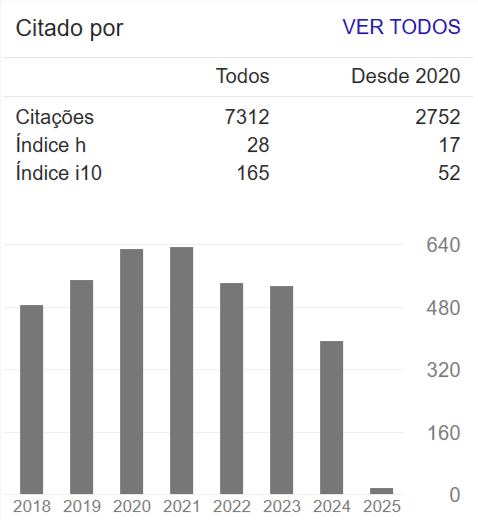Estimates of hydrogeological potential in unconfined aquifer from the transverse electrical resistance parameter
Abstract
The Barreiras Aquifer is a porous aquifer and has a predominantly unconfined hydraulic character, and it is the main water resource of the eastern coast of the Rio Grande do Norte State. The lack of reliable well data hinders the ability to prospect more promising areas for water exploitation, particularly outside urban perimeters. The research is based on the use of geoelectric methods, particularly the transverse electrical resistance parameter, as well as aquifer test for hydraulic parameters estimates, to identify areas with higher hydrogeological potentialities, targeting an area in the lower course of the Maxaranguape-RN river. The results show a strip in the center of the area with transverse electrical resistances greater than 25,000 Ohm.m², which were derived from vertical electrical sounding-VES data inversion and are associated with subareas of higher thicknesses and/or average resistivity of saturated zone. Linear regression analysis reveals that the average transversal resistivity of the saturated zone is strongly correlated to hydraulic conductivities, but not with the thickness of the saturated zone. Additionally, a map of hydraulic transmissivity estimates for the area was obtained considering geoelectric calibration and aquifer test in adjacent well. This highlights the range of higher transverse electrical resistance, which in turn has higher hydraulic transmissivities and, therefore are the most promising areas for future well location.
References
ALVES, R.S., MELO, J.G., SILVA, C.T.X.L., OLIVEIRA, C.C.C. Recursos hídricos subterrâneos da região de Parnamirim, RN: uso das águas e potencialidades. Águas Subterrâneas 30, 37, 2016. https://doi.org/10.14295/ras.v30i1.28486
ALVES, R. S., LUCENA, L.R.F. Uso de dados hidrogeofísicos e modelos numéricos como alternativa na otimização de loca-ções de poços em um aquífero não confinado. Águas Sub-terrâneas 35, 51–64, 2021.
https://doi.org/10.14295/ras.v35i1.29987
ANGELIM, L. A. A., MEDEIROS, V. C., NESI, J. R. Programa Geologia do Brasil – PGB. Projeto Geologia e Recursos Mine-rais do Estado do Rio Grande do Norte. Mapa geológico do Estado do Rio Grande do Norte. Escala. 1:500.000. Recife: CPRM/FAPERN, 2006. http://geobank.sa.cprm.gov.br.
BALSAMO, F., STORTI, F., SALVINI, F., SILVA, A. T., LIMA, C. C. Structural and petrophysical evolution of extensional fault zones in low-porosity, poorly lithified sandstones of the Barreiras Formation, NE Brazil. Journal of Structural Geology, 32, p. 1806-1826, 2010.
https://doi.org/10.1016/j.jsg.2009.10.010
BEZERRA, F.B.R. Neotectonics in northeastern Brazil. PhD Thesis. University of London, 1998.
BEZERRA, F.H.R., AMARO, V.E., VITA-FINZI, C., SAADI, A. Plio-cene-Quaternary fault control of sedimentation and coastal plain morphology in NE Brazil. Journal of South American Earth Sciences 14, 61–75, 2001. https://doi.org/10.1016/S0895-9811(01)00009-8
BEZERRA, F.H.R., ROSSETTI, D.F., OLIVEIRA, R.G., MEDEIROS, W.E., BRITO NEVES, B.B., BALSAMO, F., NOGUEIRA, F.C.C., DANTAS, E.L., ANDRADES FILHO, C., GÓES, A.M. Neotectonic reactivation of shear zones and implications for faulting style and geometry in the continental margin of NE Brazil. Tectonophysics, 614, 78–90, 2014.
https://doi.org/10.1016/j.tecto.2013.12.021
BOBACHEV, A. A., MODIN, I. N., SHEVNIN, V. A. IPI2Win v. 2.1, IPI_RES2, IPI_RES3, User’s Guide. Moscow, Russia: Ge-oscan-M Ltd, 2000.
BRAGA, A.C. O. UNESP - Universidade Estadual Paulista, 2006.
BRAGA, A.C. O. Geofísica aplicada: métodos geoelétricos em hidrogeologia. Oficina de Textos, 2016.
CHRISTAKOS, G. Modern spatiotemporal geostatistics. New York: Oxford Univ. Press, 2000.
FEITOSA, F.A.C., MANOEL FILHO, J., FEITOSA, E.C., DEME-TRIO, J.G.A.Hidrogeologia - conceitos e aplicações. 3. ed. rev. e ampl. Rio de Janeiro: CPRM / LABHID, 2008.
GOTELLI, N.J., ELLISON, A.M. Princípios de estatística em ecologia. Tradução: Fabrício B. Baccaro et al. Porto Alegre: Artmed, 2011.
IPT. Estudo hidrogeológico regional detalhado do Estado do Rio Grande do Norte. Instituto de Pesquisas Tecnológicas do Estado de São Paulo S/A. Natal. 389 p. Secretaria de Indústria e Comércio do Estado do Rio Grande do Norte. Relatório técnico IPT nº 15.795, 1992.
KIRSCH, R. Groundwater Geophysics, a tool for hydrogeology. Germany: Springer, 2009. https://doi.org/10.1007/978-3-540-88405-7
LANDIM, P. M. B. Análise estatística de dados geológicos. 2. ed. São Paulo: Ed. UNESP, 2003.
LUCENA, L.R.F., QUEIROZ, M.A. Considerações sobre as in-fluências de uma tectônica cenozóica na pesquisa e pros-pecção de recursos hídricos - o exemplo do litoral sul de Natal-RN, Brasil. Águas Subterrâneas 15, 1996.
https://doi.org/10.14295/ras.v15i1.28579
LUCENA, L.R.F. Implicação da compartimentação estrutural no Aquífero Barreiras na área da bacia do Rio Pirangi-RN. Tese (Doutorado) - Universidade Federal do Paraná, 2005.
LUCENA, L.R.F.; ROSA FILHO, E.F. DA; HINDI, E.C. O controle estrutural no aqüífero barreiras - área. Águas Subterrâneas, 20, 83–98, 2006. https://doi.org/10.14295/ras.v20i1.9715
LUCENA, L. R. F., MEDEIROS, W. E., OLIVEIRA JR, J. G, QUEI-ROZ, M. A. The potential of the Barreiras Aquifer in the lower course of the Doce River, Rio Grande do Norte State, North-east Brazil – Integration of hydrogeological and geophysical data. Brazilian Journal of Geophysics, RBGf, v. 31, n. 1, p. 43-57, 2013. https://doi.org/10.22564/rbgf.v31i1.245
MELO, J.G., MORAIS, S.D. O., SILVA, R.A. VASCONCELOS, M.B.M.B. 2013. Avaliação Dos Recursos Hídricos Do Aquífero Barreiras Na Bacia Do Rio Maxaranguape - RN. Águas Subter-râneas v. 27, p. 53–64, 2013.
https://doi.org/10.14295/ras.v27i1.26875
MELO, J.G. DE, ALVES, R.D.S., DA SILVA, J.G. Estimativa da recarga das águas subterrâneas do sistema Aquífero Barrei-ras na Bacia do rio Pirangi, RN. Águas Subterrâneas, 2014. https://doi.org/10.14295/ras.v28i2.27428
NOGUEIRA, F.C.C., BEZERRA, F.H.R., CASTRO, D.L. Deforma-ção rúptil em depósitos da Formação Barreiras na porção leste da Bacia Potiguar. Geologia USP. Série Científica 6, 51–59, 2006.https://doi.org/10.5327/S1519-74X2006000300007
NOGUEIRA, F.C., BEZERRA, F.H.R., FUCK, R.A. 2010. Quater-nary fault kinematics and chronology in intraplate north-eastern Brazil. Journal of Geodynamics 49, 79–91. https://doi.org/10.1016/j.jog.2009.11.002
NUNES, L.M.G., LUCENA, L.R.F., SILVA, C.C.N. Reserve evalu-ation of a fault-conditioned aquifer: the Barreiras Aquifer in the coastal region of NE Brazil. Brazilian Journal of Geology 50, 1–13, 2020. https://doi.org/10.1590/2317-4889202020180127
ORELLANA, E. Prospección geoeléctrica en corriente contin-ua. Madrid: Paraninfo, 1972.
PFALTZGRAFF, P.A. S., TORRES, F.S. M. Geodiversidade do Estado do Rio Grande do Norte. Recife: CPRM, 2010. 227p. Disponível em www.cprm.gov.br.
ROSSETTI, D.F., BEZERRA, F.H.R., GÓES, A.M., NEVES, B.B.B. S
ediment deformation in Miocene and post-Miocene strata, Northeastern Brazil: Evidence for paleoseismicity in a pas-sive margin. Sedimentary Geology, 235, p. 172–187, 2011. https://doi.org/10.1016/j.sedgeo.2010.02.005
SERHID. Estudos hidrogeológicos para o Plano de Recursos do Estado do Rio Grande do Norte. Natal RN: Secretaria de Estado de Recursos Hídricos, 2006.
SILVA, L. R. D., LUCENA, L. R. F., VIEIRA, M. M., NASCIMENTO, A. F. Estimativa de parâmetros hidráulicos do Aquífero Bar-reiras-RN a partir de análise computacional de imagens de lâminas delgadas. Revista Águas Subterrâneas, v. 28, p. 14-27, 2014. http://dx.doi.org/10.14295/ras.v28i2.27873
SOUPIOS, P.M., KOULI, M., VALLIANATOS, F., VAFIDIS, A., STAVROULAKIS, G. Estimation of aquifer hydraulic parame-ters from surficial geophysical methods: A case study of Keritis Basin in Chania (Crete – Greece). Journal of Hydrolo-gy, v. 338, p. 122-131, 2007.
https://doi.org/10.1016/j.jhydrol.2007.02.028
SOUZA, Z.S., JARDIM DE SÁ, E.F., MARTIN, H. Metagranitóides do complexo caicó, NE do Brasil: aspectos geoquímicos de um magmatismo cálcico-alcalino na transição arqueano - paleoproterozóico. Boletim IG-USP. Publicação Especial 55, 1996. https://doi.org/10.11606/issn.2317-8078.v0i18p55-57
SOUZA, I.V.F. DE, LUCENA, L.R.F. DE, BEZERRA, F.H.R., DINIZ FILHO, J.B. Use of hydrogeophysical data to determine the role of faults in the geometry of the Barreiras Aquifer, Brazil. Brazilian Journal of Geology, v. 49, 2019.
https://doi.org/10.1590/2317-4889201920170141
STEIN, P., DIZ FILHO, J.B., LUCENA, L.R.F., CABRAL, N.M.T. Qualidade das águas do aquífero Barreiras no setor sul de Natal e norte de Parnamirim, Rio Grande do Norte, Brasil. Revista Brasileira de Geociências, v. 42, p. 226–237, 2012. https://doi.org/10.5327/Z0375-75362012000500018
SURFER. Contouring and 3D Surface Mapping for Scientists and Engineers. Colorado, USA: olden Software, Inc. Golden, 2010. http://www.goldensoftware.com
UTOM, A.U., ODOH, B.I., OKORO, A.U. Estimation of Aquifer Transmissivity Using Dar Zarrouk Parameters Derived from Surface Resistivity Measurements: A Case History from Parts of Enugu Town (Nigeria). Journal of Water Resource and Protection, v. 4, p.993-1000, 2012.
http://dx.doi.org/10.4236/jwarp.2012.412115
YORUM, R., HUBBARD, S.S. Hydrogeophysics. Springer. USA, 2005.
YUSUF, S.N., ISHAKU, J.M., WAKILI, W.M. Estimation of Dar-Zarrouk parameters and delineation of groundwater poten-tial zones in Karlahi, part of Adamawa Massif, Northeastern Nigeria. Warta Geologi, v. 47, n. 2, p. 103–112, 2021. https://doi.org/10.7186/wg472202101.

















